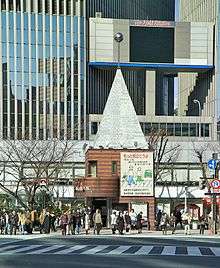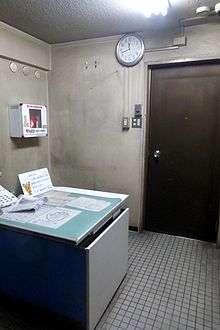Kōban



A kōban (交番 kōban) is a small neighborhood police station found in Japan. Kōban also refers to the smallest organizational unit in today's Japanese police system.[1] In addition to central police stations found across the country, uniformed police work is done from small kōban buildings located within the community, a form of community policing. As of 2007, there are about 6,000 kōban all over Japan.[2] Since the 1990s, many of them are found with signs in Latin letters: "KOBAN".[3][4]
Overview
A kōban is typically a one to two-storied housing with a couple of rooms (although there is wide variation), with one to more than ten police officers.[5] The officers in these buildings can keep watch, respond to emergencies, give directions, and otherwise interact with citizens on a more intimate basis than they could from a more distant station. Although often translated to English as "police box",[6] the kōban bears little resemblance to the British police box.
History
The name kōban derives from the name of the earliest structure built in 1874, which were indeed simple boxes meant for standing watch (立番 tachiban) in rotation (交替 kōtai), thus creating a compound word consisting of kō (交) and ban (番).[7] Soon after, in 1881, kōban were transformed into local community stations with as many as six officers and a new official name Hashutsujo (派出所) was given to it — although its common name, "kōban" survived. "Kōban" was further systematized and spread out nationwide, playing an important role in the Japanese police system over decades. In 1994 the official name Hashutsujo (派出所) was changed back to kōban. One of the issues recognized in the last several years as most significant around the kōban system was the existence of aki-kōban (空き交番, un-manned stations). According to the National Police Agency, this issue was addressed and solved by 2007.[2]
Small police stations similar to the Japanese kōban are also found in parts of China and Singapore.[8] Additionally, the kōban system has become popular with international police training and assistance programs, particularly those of the Japan International Cooperation Agency (JICA). JICA has invested money in establishing kōban-style community policing programs in several countries, including Indonesia, Brazil, and Honduras.[9]
In 2017, the TMPD has been posting officers in kobans who speak more than one language to help tourists and foreign expats, using the Kabukicho Koban in Shinjuku and the Shibuya Ekimae Koban.[10]
Services provided
_from_Sudo-cho.jpg)

Police officers stationed at kōban serve several roles:
- Maps and directions – providing maps and directions to local addresses, sometimes even personally guiding those unfamiliar with local street layouts and addressing schemes. Additionally, officers can refer people to local hotels, restaurants, and other businesses.
- Lost and found – accepting reports of lost items and accepting found items from members of the public and, if a matching lost item is turned in, notifying the owner of the item to come pick up the item.
- Crime reports – taking police reports, typically for property crimes such as theft and burglary.
- Emergency services – dialing the emergency telephone number "110" in the case of police, fire, or medical emergency. Direct contact can be made with the kōban and assistance will be dispatched.
See also
References
- ↑ Jones, Trevor; Tim Newburn (2006). Plural policing. Routledge. pp. 232–33. ISBN 0-415-35510-9.
- 1 2 Enhancement plan of kōban functionality (今後の交番機能の強化対策の推進について) Archived 2009-07-18 at the Wayback Machine., National Police Agency of Japan, viewed April 8, 2009 (in Japanese)
- ↑ Parker, L Craig (2001). The Japanese police system today. ME Sharpe. pp. 38–58. ISBN 0-7656-0762-X.
- ↑ "Landmark", Kōban, Japan: Metropolitan Police Department, archived from the original on September 8, 2012, retrieved April 9, 2009 — official signs
- ↑ Toyozaki, Yoko; Stuart Varnam-Atkin (2008). 日本風物詩 [Are Japanese Cats Left-handed?]. Translated by Sawada Gumi. IBC Publishing. pp. 19–21. ISBN 4-89684-581-1.
- ↑ "'kōban' translated as 'police box'", Books (search), Google
- ↑ Activities of kōban (交番・パトカーの活動) (in Japanese), Japan: Metropolitan Police Department, archived from the original on September 8, 2012, retrieved April 8, 2009
- ↑ https://mothership.sg/2017/01/spores-neighbourhood-police-posts-were-inspired-by-japanese-kobans/
- ↑ "4. Consolidación de la Democracia", El Salvador (in Spanish), JP: JICA, archived from the original on July 13, 2009, retrieved February 13, 2009 .
- ↑ http://www.keishicho.metro.tokyo.jp/multilingual/english/about_us/activity/koban.html
External links
| Wikimedia Commons has media related to Kobans in Japan. |